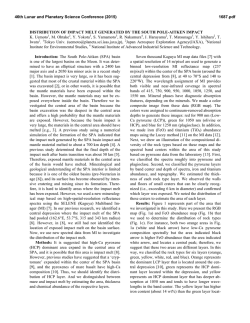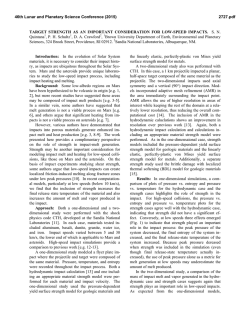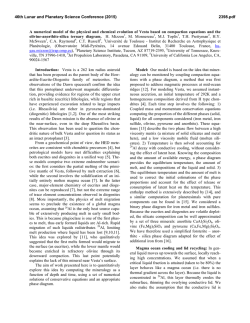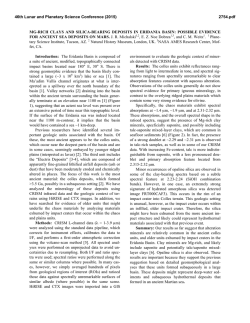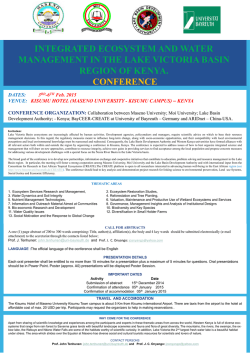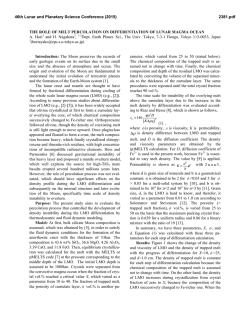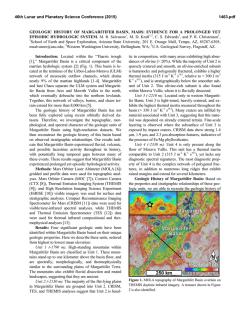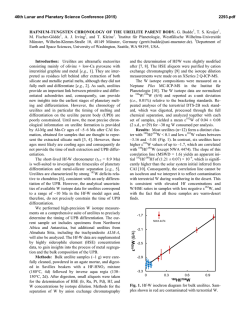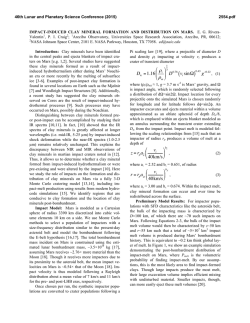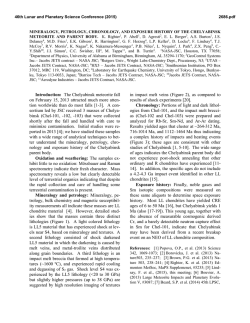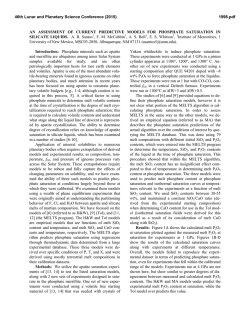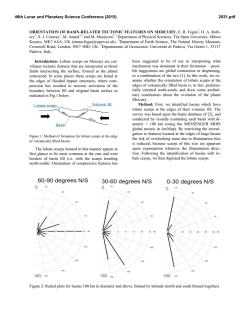
IMPACT MELT FROM LUNAR MULTI-RING BASINS - USRA
46th Lunar and Planetary Science Conference (2015) 1853.pdf IMPACT MELT FROM LUNAR MULTI-RING BASINS: ORIENTALE AND IMBRIUM P.D. Spudis, Lunar and Planetary Institute, Houston TX 77058; J.N. Murl, Univ. Hawaii, Honolulu HI 96822 Introduction. The largest impacts on the Moon – those that form the multi-ring basins – produce thousands of cubic kilometers of shock-created melt [e.g., 1]. This melt is largely concentrated inside the basin, although some is ejected along with the clastic materials that make up most of the continuous ejecta blanket that surrounds basins [1, 2]. Impact melt is important because it contains information on the crustal target for basins as well as being the most suitable material to date basin-forming events. New geological mapping of the lunar Orientale [3] and Imbrium [4] impact basins provides the opportunity to identify likely deposits of impact melt and study their composition to better understand lunar crustal composition and basinforming processes. Morphological criteria for the recognition of impact melt. Deposits of impact melt have distinct and welldefined morphologic features that permit their recognition from images [2, 5]. Typically, impact melt is found on the floors of fresh craters, showing fissured, cracked and ponded surfaces. Melt deposits form pools and flows in the walls and rims of complex craters [5, 6] and are sometimes found at large radial distances from the crater rim, where melt can make up flows that appear to have segregated from the clastic debris. While fissures and cracks do not certify a deposit as being of melt origin, they often serve as prima facie indicators of such an origin. The great age of lunar basins means that most pristine morphologies have been erased by impact erosion and burial by subsequent units, but the youngest basins preserve portions of their original morphology. Both Orientale and Imbrium are among the youngest lunar basins and show many features that may be interpreted as primary textures. In this study, the mapped facies of ejecta from these basins were examined and deposits consistent with an origin by impact melting were identified. For each impact melt deposit, we collected compositional data from Clementine multi-spectral images [7] and Lunar Prospector gamma-ray data [8], allowing us to estimate the chemical composition of these melt deposits and assess their variability. These observations and compositional data were then evaluated against physical models for the generation of impact melts [5, 6, 9] and an attempt was made to identify possible samples in the Apollo collections that have attributes consistent with an origin as impact melt from either of these basins. Orientale. The Orientale basin (930 km diameter) is well preserved and only partly flooded by later mare basalts [1-3]. The basin interior melt sheet is represented by the Maunder Formation, a smooth-tofissured surface unit that covers the innermost basin ring. Study of the composition of the Maunder Fm. as determined by remote sensing shows that it is remarkably uniform both laterally and vertically, with no evidence of differentiation [3]. Portions of the Montes Rook Fm., defined primarily by its knobby texture, appears to have flowed in some locations [3] and may consist at least in part of a substantial amount of impact melt [10]. In addition, two localized deposits (each about 10 km in extent) have been identified overlying the Cordillera scarp (basin main rim). These deposits display cracked surface morphology and are to be likely ponds of impact melt. Surrounding the Orientale basin are extensive deposits of textured ejecta, most of which are probably made up largely of unmelted, clastic materials. Flow lobes and scarps appear in some localities (e.g., near Inghirami; 51°S, 68°W); while it is not certain that these features are impact melt, they might be. Other deposits randomly distributed throughout the radially textured Hevelius Fm. [2, 3, 10] show cracked and fissured surfaces. These features are similar to fissured ponds of material found around fresh craters such as Tycho and are likely to consist of deposits of ejected basin impact melt. A few isolated deposits contained within some basin secondary craters appear melt-like, with low albedo and a cracked surface texture (e.g., Struve L; 20.7°N, 76°W). The chemical composition of these isolated deposits of cracked and fissured materials are all similar to the composition of the Maunder Fm., the main melt sheet located inside the Orientale basin (Figure 1). Imbrium. The slightly larger (1160 km diameter) and older Imbrium basin is mostly filled with mare basalt lava, concealing most of the basin floor [2]. The Imbrium basin rim (Apennine ring) displays extensive slumping near Mons Bradley (20.8°N, 2.3°W) on top of which occur fissured and cracked, low albedo deposits. These features have been interpreted as Imbrium basin impact melt [2]. At one time, the planar Apennine Bench Fm. (26°N, 2.5°W) had been thought to be the Imbrium equivalent of Orientale’s Maunder Fm. i.e., the impact melt sheet of the Imbrium basin [11]. However, pristine volcanic KREEP basalt found at the nearby Apollo 15 landing site are likely to be pieces of this material and thus, the Apennine Bench Fm. is probably derived from early volcanic infilling of the Imbrium basin [12]. Outside of the basin rim, several areas exhibit morphology consistent with an origin as ejected impact 46th Lunar and Planetary Science Conference (2015) melt. The floor of the crater Murchison (5.1°N, 0.1°W) shows a complex, fissured and cracked surface, in addition to textures suggestive of partial flow. This material is gradational with the Fra Mauro Fm. (basin ejecta) that covers the crater rim. Other occurrences of probable basin melt are found in the secondary craters of the central highlands, including the craters Andel M (9.9°S, 11°E), Parrot C (18.5°S, 1.2°E) and especially, Airy (18.1°S, 5.1°E). These deposits have low albedo and show cracked surfaces, with some evidence of ground flow after deposition. The Airy deposit also has a low albedo under high sun illumination, suggesting a more iron-rich composition than the surrounding (feldspathic) highlands. Ejected melt deposits contrast strongly in composition with their Orientale basin counterparts, being more mafic (Fig. 1). Typical Imbrium melt has FeO between 8 and 10 wt.%, significantly higher than the 45 wt.% of Orientale Maunder Fm. and the small ejected melt ponds found within the Orientale ejecta (Fig.1). The Imbrium basin melts fall close to or broadly within the field defined by the Fra Mauro Fm., the predominantly clastic ejecta blanket of the basin. These results indicate that the target rocks for the Imbrium basin impact were distinctly different from those of the Orientale basin, consistent with Imbrium’s position within the Procellarum geochemical province. Implications for Interpretation of Apollo Highland Samples. Analysis of the main melt sheet for Orientale and ejected melt ponds for both the Orientale and Imbrium basins suggest several points to consider when searching the Apollo sample collections for basin impact melt candidates. The candidate melt should posses a composition broadly similar to those measured for the regional deposits. Some melt rocks are clearly not basin-related (e.g., those that are very feldspathic or identical to the local soils). The composition of Orientale melt (both the main melt sheet and the ejected ponded melt) is similar to noritic anorthosite. Sample 68415, from the Apollo 16 landing site, has bulk chemical composition similar to the Orientale melt sheet [13] and a crystallization age compatible with that event (3.78 Ga; [14]). Interestingly, this sample has been proposed to derive from Orientale basin ejecta [15]. The Imbrium melt deposits are more mafic than those of the Orientale basin. No remnant of the inner basin melt sheet of Imbrium is evident, but the ejected impact melts are remarkably similar to a variety of highland basaltic impact melts found in the Apollo collections, such as the Apollo 15 and 17 mafic melt breccias [1]. The Apollo 15 landing site lies a couple of hundred km north of the best exposed Imbrium melt pond, also occurs along the Apennine scarp and contains such rocks. The best candidates for Imbrium 1853.pdf basin impact melt from this landing site are the black and white breccias 15445 and 15455 [16]. These melt rocks are relatively mafic and similar in composition to the identified isolated melt ponds of Imbrium (Fig. 1). Conclusions. We have identified ejected melt deposits from the Orientale and Imbrium impact basins. Ejected melt from a single basin appears to be relatively homogeneous and (in the case of Orientale), similar to that of the main melt sheet. The two basins have differing and distinct compositions, with Orientale being relatively feldspathic (noritic anorthosite) and that of the Imbrium basin being more mafic (highland basalt). The identification of these features offer the possibility of examining basin impact melt at distances far removed from basin interiors or from basins that are deeply flooded by mare lava, covering the interior melt sheet. As such, these isolated deposits of basin impact melt are important sites for future sample-return missions. References. [1] Spudis P.D. (1993) Geology of MultiRing Basins, Cambridge Univ. Press, 263 pp. [2] Wilhelms D.E. (1987) USGS PP 1348, 302 pp. [3] Spudis P.D. et al. (2014) JGR 199, 1. [4] Murl J.N. et al. (2015) this vol. [5] Howard K.A. and Wilshire H.G. (1975) J. Res. USGS 3, 237. [6] Hawke B.R. and Head J.W. (1977) Impact Explosion Cratering, Pergamon, 815. [7] Lucey P.G. et al. (2000) JGR 105, 20297. [8] Lawrence D. et al. (2007) GRL 34, 3. [9] Phinney W.C. et al. (1977) Impact Explosion Cratering, Pergamon, 771. [10] McCauley J.F. (1977) PEPI 15, 220. [11] McCauley J.F. et al (1981) Icarus 47, 184. [12] Spudis P.D. (1978) PLPSC 9, 3379. [13] Spudis P.D. (2014) AGU Ann. Mtg. Abs. P12B-03 [14] 68415 data sheet, NASA-JSC [15] Hodges C.A. et al. (1973) PLSC 4, 1. [16] Ryder G. and Bower J. (1977) PLSC 8, 1895. Figure 1. Composition of Orientale (blue dots) and Imbrium (red dots) ejected impact melt ponds. Compositional fields of major basin ejecta formations also shown.
© Copyright 2025
